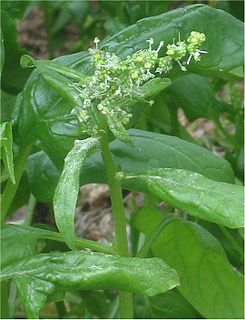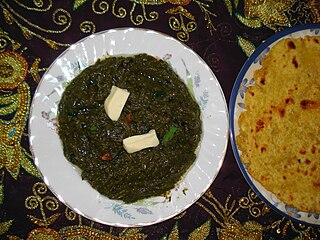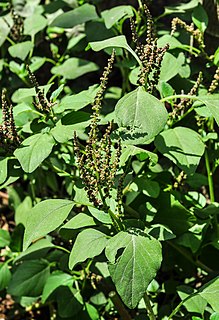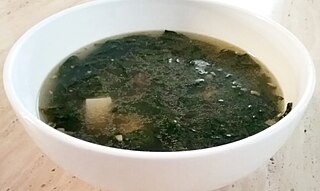
Spinach is a flowering plant native to central and western Asia. It is of the order Caryophyllales, family Amaranthaceae, and subfamily Chenopodioideae. Its leaves are an edible vegetable consumed either fresh, or after storage by canning, freezing, or dehydration.
Chinese cabbage can refer to two groups of Chinese leaf vegetables often used in Chinese cuisine: the Pekinensis Group and the Chinensis Group.

Saag or saga is a leaf-based dish eaten in the Indian subcontinent with bread such as roti or naan, or rice. Saag can be made from spinach, mustard leaves, finely chopped broccoli, or other greens, along with added spices and sometimes other ingredients such as paneer. It is occasionally referred to as saagwala.

Bok choy, pak choi or pok choi is a type of Chinese cabbage. Chinensis varieties do not form heads and have green leaf blades with lighter bulbous bottoms instead, forming a cluster reminiscent of mustard greens. Chinensis varieties are popular in southern China and Southeast Asia. Being winter-hardy, they are increasingly grown in Northern Europe. This group was originally classified as its own species under the name Brassica chinensis by Linnaeus. They are a member of the family of Brassicaceae or Cruciferae, also commonly known as the mustards, the crucifers, or the cabbage family.
Caihuying is an overpass complex in southwestern urban Beijing.

Choy sum is a leafy vegetable commonly used in Chinese cuisine. It is a member of the genus Brassica of the mustard family, Brassicaceae. Choy sum is a transliteration of the Cantonese name, which can be literally translated as "heart of the vegetable". It is also known as Chinese flowering cabbage.

Ipomoea aquatica is a semi-aquatic, tropical plant grown as a vegetable for its tender shoots and leaves. It is found throughout the tropical and subtropical regions of the world, although it is not known where it originated. This plant is known in English as water spinach, river spinach, water morning glory, water convolvulus, or by the more ambiguous names Chinese spinach, Chinese Watercress, Chinese convolvulus, swamp cabbage or kangkong in Southeast Asia. Occasionally, it has also been mistakenly called "kale" in English, although kale is a variety of cabbage and is completely unrelated to water spinach, which is a species of morning glory.

Basella alba is an edible perennial vine in the family Basellaceae. It is found in tropical Asia and Africa where it is widely used as a leaf vegetable. It is native to the Indian Subcontinent, Southeast Asia and New Guinea. It is reportedly naturalized in China, tropical Africa, Brazil, Belize, Colombia, the West Indies, Fiji and French Polynesia.

Callaloo is a popular Caribbean dish originating in West Africa served in different variants across the Caribbean. The main ingredient is a leaf vegetable, traditionally either amaranth, taro or Xanthosoma. Because the leaf vegetable used in some regions may be locally called "callaloo" or "callaloo bush" "Dasheen Leaves", some confusion can arise among the vegetables and with the dish itself. In Haiti, for example, the creole word "kalalou" refers to okra, and not to a leafy green. Outside of the Caribbean, water spinach is occasionally used. Trinidadians, Grenadians and Dominicans primarily use taro/dasheen bush for callaloo, although Dominicans also use water spinach. Jamaicans, Belizeans and Guyanese on the other hand use the name callaloo to refer to amaranth, and use it in a plethora of dishes and also a drink. The 'callaloo' made in Jamaica is different from the 'callaloo' made in Trinidad and Tobago Grenada and rest of the Caribbean in terms of main ingredient and other ingredients included. "callaloo" in Trinidad is used in a variety of dishes including Callaloo soup "callaloo bhaji" two Trinidads specialities. Callaloo is the National Dish of the twin Island Republic of Trinidad and the Commonwealth of Dominica.
Jīngzhé, Keichitsu, Gyeongchip, or Kinh trập is the 3rd of the 24 solar terms (節氣) in the traditional East Asian calendars. It begins when the Sun reaches the celestial longitude of 345° and ends when it reaches the longitude of 360°. More often, it refers to the day when the Sun is exactly at a celestial longitude of 345°. In the Gregorian calendar, it usually begins around March 5 and ends around March 20.

Amaranthus viridis is a cosmopolitan species in the botanical family Amaranthaceae and is commonly known as slender amaranth or green amaranth.

Tatsoi is an Asian variety of Brassica rapa grown for greens. This plant has become popular in North American cuisine as well, and is now grown throughout the world.

Dongtou (help·info) is a district consisting of 168 islands in the East China Sea, and is under the jurisdiction of prefecture-level city of Wenzhou, in southern Zhejiang province, China. It has a total area of 2,700.3 km2 (1,042.6 sq mi), of which 100.3 km2 (38.7 sq mi) is land, and, as of 2012, had a population of 130,600. It was known as Dongtou County (洞头县) until 2 September 2015, when, with the approval of the State Council, it was converted to a district.

Choy Weng Yang is a Singaporean artist, curator and arts writer and a proponent of the art fraternity in post-independent Singapore. His literary contributions on post-modern arts in Singapore, had helped shaped the contemporary art scene in Singapore.

Meigan cai (simplified Chinese: 梅干菜; traditional Chinese: 霉乾菜; pinyin: méigān cài; Wade–Giles: mei2-kan1 ts'ai4; literally: 'molded dried vegetable'; or mei cai is a type of dry pickled Chinese mustard of the Hakka people from Huizhou, Guangdong province, China. Meigan cai is also used in the cuisine of Shaoxing, Zhejiang province, China and in Taiwan.

Stir fried water spinach is a common Asian vegetable dish of stir-fried water spinach. It is a popular Asian vegetable dish, commonly found throughout East, South and Southeast Asia; from Sichuan and Cantonese cuisine in China, to Vietnamese, Malaysian, Singaporean and Indonesian cuisine in Southeast Asia to Sri Lankan cuisine and Bengali cuisine in South Asia. As a result, it is known by many names; such as tumis kangkung or cah kangkung in Indonesia, kangkong goreng in Malaysia, rau muống xào in Vietnam, stir fry kong xin cai (空心菜), stir fry tung choy or ong choy (通菜) in China, kankun mallung in Sri Lanka and kolmi shak bhaja in Bangladesh and eastern India.

Buddha's delight, often transliterated as Luóhàn zhāi, lo han jai, or lo hon jai, is a vegetarian dish well known in Chinese and Buddhist cuisine. It is sometimes also called Luóhàn cài.

Patriotic soup is a vegetable soup originated by Teochew people. It is developed during the final year of China's Song dynasty.

















